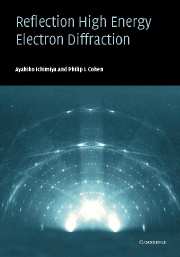Book contents
- Frontmatter
- Contents
- Preface
- 1 Introduction
- 2 Historical survey
- 3 Instrumentation
- 4 Wave properties of electrons
- 5 The diffraction conditions
- 6 Geometrical features of the pattern
- 7 Kikuchi and resonance patterns
- 8 Real diffraction patterns
- 9 Electron scattering by atoms
- 10 Kinematic electron diffraction
- 11 Fourier components of the crystal potential
- 12 Dynamical theory – transfer matrix method
- 13 Dynamical theory – embedded R-matrix method
- 14 Dynamical theory – integral method
- 15 Structural analysis of crystal surfaces
- 16 Inelastic scattering in a crystal
- 17 Weakly disordered surfaces
- 18 Strongly disordered surfaces
- 19 RHEED intensity oscillations
- Appendix A: Fourier representations
- Appendix B: Green's functions
- Appendix C: Kirchhoff's diffraction theory
- Appendix D: A simple eigenvalue problem
- Appendix E: Waller and Hartree equation
- Appendix F: Optimization of dynamical calculation
- Appendix G: Scattering factor
- References
- Index
7 - Kikuchi and resonance patterns
Published online by Cambridge University Press: 06 July 2010
- Frontmatter
- Contents
- Preface
- 1 Introduction
- 2 Historical survey
- 3 Instrumentation
- 4 Wave properties of electrons
- 5 The diffraction conditions
- 6 Geometrical features of the pattern
- 7 Kikuchi and resonance patterns
- 8 Real diffraction patterns
- 9 Electron scattering by atoms
- 10 Kinematic electron diffraction
- 11 Fourier components of the crystal potential
- 12 Dynamical theory – transfer matrix method
- 13 Dynamical theory – embedded R-matrix method
- 14 Dynamical theory – integral method
- 15 Structural analysis of crystal surfaces
- 16 Inelastic scattering in a crystal
- 17 Weakly disordered surfaces
- 18 Strongly disordered surfaces
- 19 RHEED intensity oscillations
- Appendix A: Fourier representations
- Appendix B: Green's functions
- Appendix C: Kirchhoff's diffraction theory
- Appendix D: A simple eigenvalue problem
- Appendix E: Waller and Hartree equation
- Appendix F: Optimization of dynamical calculation
- Appendix G: Scattering factor
- References
- Index
Summary
Kikuchi lines
Inelastically scattered electrons play an important role in the formation of the RHEED pattern. The primary inelastic process is a scattering event involving phonons and plasmons (Horio, 1996; Müller and Henzler, 1997). The intensity of these Kikuchi patterns depends strongly on the surface morphology, since scattering from small terraces and steps broadens them. Sharp Kikuchi lines are obtained from crystals with perfect surfaces and perfect bulk lattices. They seem to be stronger for heavier materials; for example, Si and SiC show strong Kikuchi patterns but GaAs, GaN and PbS show weaker patterns.
As will be discussed in Chapter 16, the inelastic scattering is peaked in the forward direction in a diffuse cone of about 0.1° for single-plasmon scattering and of more than 10° when multiple thermal diffuse scattering is important (Ichimiya, 1972). The inelastically scattered electrons in this diffuse cone can subsequently be diffracted by the crystal lattice planes, depending on their angle. These two scattering processes combine to give rise to the appearance of Kikuchi lines at specific exit angles. Figure 7.1 shows the energy distribution of the electrons scattered into a Kikuchi line which crosses the specular beam from Si(111) (Nakahara et al., 2003). The main contributions in the spectrum are surface and bulk plasmons, because the energy-loss spectra from thermal diffuse scattering (or phonon scattering) are not resolved owing to poor resolution of the spectrometer for RHEED.
- Type
- Chapter
- Information
- Reflection High-Energy Electron Diffraction , pp. 62 - 76Publisher: Cambridge University PressPrint publication year: 2004

